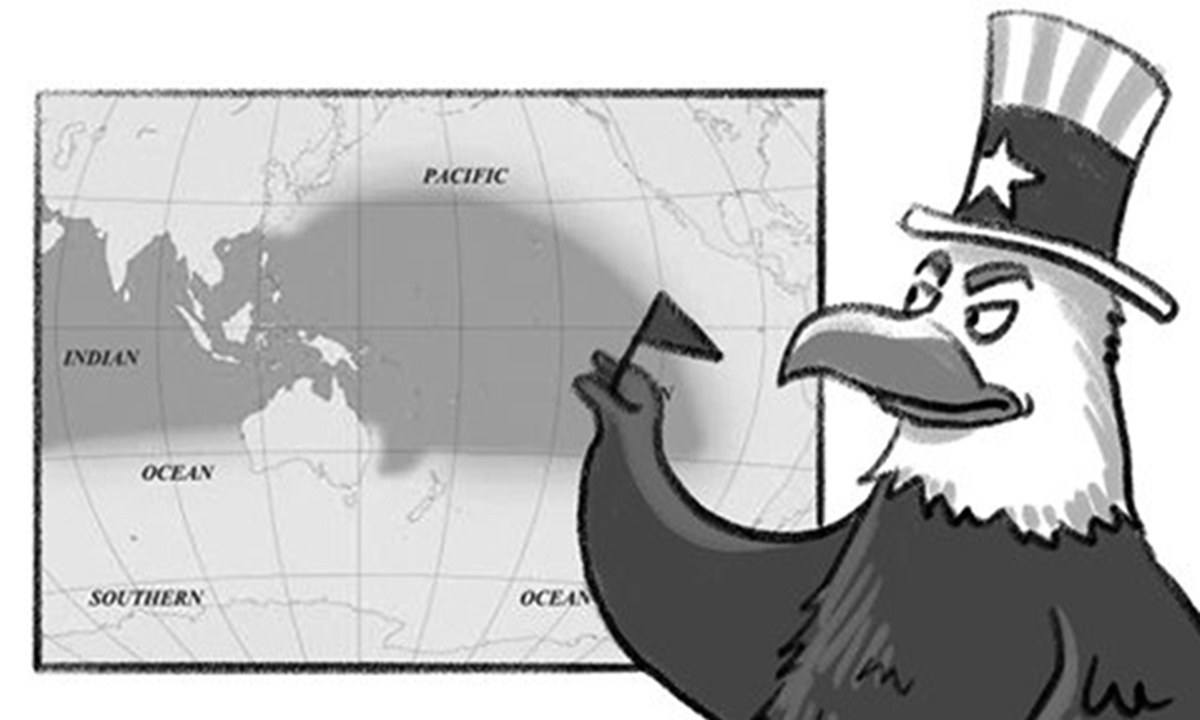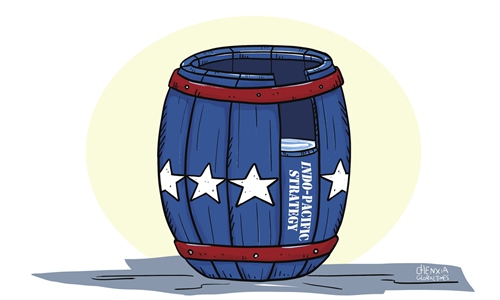
US and the Indo-Pacific Illustration: Liu Rui/GT
IPEF: What is it?The Indo-Pacific Economic Framework (IPEF) has been a geopolitical buzz term for quite some time. It all started in October 2021 during the East Asia Summit, when US President Joe Biden announced via video conference that his country will explore the development of an Indo-Pacific economic framework that will define shared objectives around trade facilitation, standards for the digital economy and technology, supply chain resiliency, decarbonization and clean energy, infrastructure, worker standards, and other areas of shared interest.
The idea was reaffirmed by the US Under Secretary of State for Economic Growth, Energy, and the Environment Jose W. Fernandez, who said in a subsequent interview that the US will engage its partners regarding the IPEF at multilateral platforms such as APEC, ASEAN, the Quad and the Indo-Pacific Business Forum.
The US soon built up momentum for the IPEF, which included holding a Summit on Global Supply Chain Resilience with Japan, India and other like-minded countries during the G20 Rome Summit, and overwhelming Asia-Pacific countries with visits by senior officials to sell the IPEF. US Commerce Secretary Gina Raimondo said at the Bloomberg New Economy Forum that America will seek to build an economic cooperation framework with its regional allies that goes beyond the Comprehensive and Progressive Agreement for Trans-Pacific Partnership (CPTPP), and that a joint statement on the IPEF will be issued with trade ministers of Singapore, Australia and New Zealand.
Describing the IPEF as an arrangement separate from China, US Trade Representative Katherine Tai expressed the hope that developed countries and emerging market economies in the region would join. US Secretary of State Antony Blinken was no less relentless, giving out his IPEF pitch at the University of Indonesia, and "holding discussions" with Southeast Asian countries in this regard.
Over the past year, the world has been preached to about America's "ambitions" on digital standards, supply-chain resilience and the like. But judging by what has been said so far, the IPEF is nothing but the same old stuff under a new label. Strengthening the semiconductor supply chain, for example, is already a priority of the Quad. And there are also several precedents in the region for common rules in the digital domain.
IPEF: What is it for?
It is fair to say that the IPEF is just another tool for the US to push its Indo-Pacific Strategy in the economic field where it previously fell short. In recent years, the US has been bristled by China's rapid economic development and growing links with other Asian economies. According to the American Enterprise Institute (AEI), the US has fallen behind in the regional trade agenda, leaving a gaping hole in its Asia strategy. And America's absence from key regional trade agreements has, in the words of the Chatham House, been made conspicuous by China's accession request to the CPTPP.
"China" is between the lines of the IPEF. For example, "to make supply chains less reliant on China", and "prevent China's access to important technologies". The policy direction is essentially one of exclusion rather than inclusion, isolation rather than integration, and confrontation rather than cooperation. So much so that some international analysts see it as another version of "America First", one that has a strong political security agenda to complement the Indo-Pacific Strategy. At the end of the day, the IPEF is more like a new weapon to serve the geopolitical and economic goals of America than a new platform to facilitate economic growth in the Asia-Pacific region.
The US has worked hard to pull together its regional allies and partners to support the Indo-Pacific Strategy in the military and security dimensions with AUKUS, Quad, FVEY and G7. But this, in fact, goes in the opposite direction of what regional countries really want: solid economic development, better livelihoods and greater social stability. That is why "America's back" hasn't been met with a warm embrace from regional countries, but instead has been met with concerns and worries about the US undermining regional stability, triggering arms races and risks of nuclear proliferation. This is the reason why the US has whitewashed the Indo-Pacific Strategy, and tailor-made the IPEF as the hanging "carrot" in front of regional countries.
Yet the dazzling American initiatives have caused nothing but aesthetic fatigue, and lip service could hardly raise any interest of regional countries. As America struggles to reckon with a crushing COVID-19 pandemic and domestic headaches such as a sluggish economic recovery, high inflation and a record-breaking fiscal deficit, one cannot help but wonder: how much could the US really spend on the IPEF? This a big question mark.
IPEF: What are the prospects?
To begin with, the throes of US domestic politics are weighing down its IPEF agenda. With political polarization, sharp bipartisan conflicts, and the mounting pressure of midterm elections for the Biden administration, it is no easy job to get the IPEF passed in Congress and implemented afterwards. Wendy Cutler, Vice President of the Asia Society Policy Institute (ASPI), suggested that "the administration will need to develop concrete initiatives that go beyond dialogues, principles and best practices, yet not as far as enforceable agreements requiring change to U.S. law."
The other hurdle is to win the trust of regional countries. America's partners in the "Indo-Pacific" have indicated that without an equally robust economic piece, the picture remains incomplete. Bloomberg pointed out that Asian nations understandably fear the whole endeavor is meant to distract from the administration's unwillingness or inability to offer greater access to the US market. Even certain Japanese officials have suspected that the IPEF is "immature at all."
As Chinese State Councilor and Foreign Minister Wang Yi stated at the meeting of the Advisory Council of the Belt and Road Forum for International Cooperation in 2021, the yardstick in judging an initiative should be whether it puts development first, whether it is open and inclusive, whether it pursues mutual benefit, and whether it is action-oriented.
For better or worse, economic globalization is still on track. This means that labor division and win-win cooperation will remain, and attempts to wrap up economic cooperation with political preconditions are bound to fall flat. It is actually quite simple. If the US really wants to serve our regional economy and gain our trust, all it needs to do is to follow the development trends of the region and the times. And it must be earnest in promoting cooperation and development, not seeking hegemony to serve its own interests.
The author is an observer on international affairs. opinion@globaltimes.com.cn

